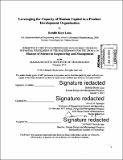Leveraging the capacity of human capital in a product development organization
Author(s)
Reyes Luna, Rodolfo
DownloadFull printable version (18.83Mb)
Other Contributors
System Design and Management Program.
Advisor
Steven D. Eppinger.
Terms of use
Metadata
Show full item recordAbstract
This research has as fundamental purpose, the generation of strategies for the product development organization in Ford of Mexico; the goal is to increase the capability of the workforce for the development of future work streams. In this thesis, a network model for organizational architectures referred as organizational design structure matrix is used to identify the main interactions among the project teams; this interaction pattern is compared to product interfaces captured in a product DSM model. A case study from Ford Motor Company is utilized; the development is narrowed to the analysis of the front end system of a new CD platform vehicle during the main stages of the product development process. To set up a context for this thesis, I elaborate the product development process from Ford and describe the main design challenges from the case study. In this thesis, I also explain the role that communication plays in an organization due to team geographic location and categories within the organization. DSM concepts and methods are explained to converge further in the application of the product development organization case study. I start the research with the creation of the product DSM for the front end system team through data collection, and interviews with the core engineering group at the company; surrogate data from current production CD vehicles was analyzed. I survey the Ford front end system team to understand the frequency and level of interaction among component teams during the development of the project. Technical maturity level of each team member is collected as well. Additional data from the program management team is acquired to cross reference project team performance with organizational communication. I compare the data set collected with the product architecture DSM to determine mismatches in the organization interactions. In addition, a series of clustering analyses are also compared to improve the team design structure matrix; these results allow us to convey strategies and recommendations to Ford of Mexico organization, to ultimately enhance the product development organization capabilities.
Description
Thesis: S.M. in Engineering and Management, Massachusetts Institute of Technology, Engineering Systems Division, System Design and Management Program, 2015. Cataloged from PDF version of thesis. Includes bibliographical references (pages 100-103).
Date issued
2015Department
System Design and Management Program.; Massachusetts Institute of Technology. Engineering Systems DivisionPublisher
Massachusetts Institute of Technology
Keywords
Engineering Systems Division., System Design and Management Program.